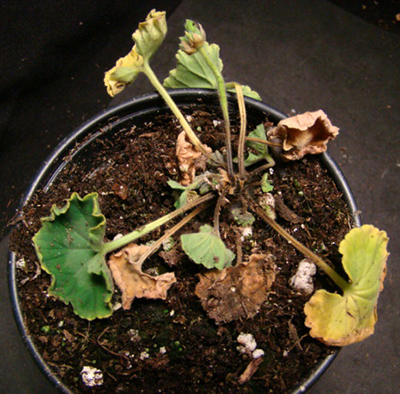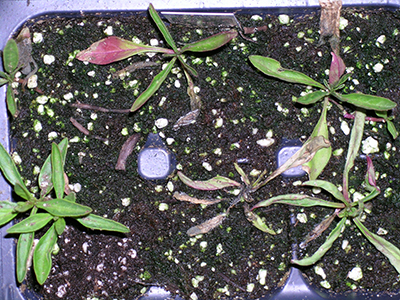P is for Pythium root rot on ornamentals
Know the ABCs of ornamental greenhouse diseases, including Pythium root rot.

Pythium crown and root rot is a common and persistent disease in the greenhouse industry. This water mold can “nibble” the feeding roots of plants, resulting in stunted growth and delayed flowering (Photo 1). Pythium can also cause severe symptoms, such as crown rot, that can result in plant death (Photos 2-4). Pythium favors wet, saturated soil conditions, such as overwatered media. The persistence of this pathogen can be traced to its ability to “hibernate” in soil particles and plant tissue found on dirty plant containers, benches, hoses and greenhouse walkways, ready to become activated by the right crop and weather conditions.
Although Pythium can be a problem on almost any greenhouse crop, plants like geranium, poinsettia and snapdragons are especially susceptible. Sanitation is a key management strategy and is important in limiting root rot. Conditions that favor good plant growth and avoiding saturated soil make the plant less vulnerable to attack by Pythium. Use a pressure washer when cleaning walkways, benches, etc. You can follow this with a disinfestant to sanitize. If you’ve followed all recommendations and still find yourself with a Pythium problem, choosing the right fungicide tools can minimize your losses.
Scouting is an important first step in controlling Pythium root rot. If Pythium had a significant head start, the root system of some plants will be too rotted to adequately recover and the fungicides will not be able to rescue them. If Subdue MAXX has been the only or primary fungicide used over the years, and Pythium continues to be an issue in your greenhouse, it is possible that the Pythium has become resistant and is no longer limited by this fungicide. To know for sure, the Pythium present in your greenhouse must be tested in a diagnostic lab. To avoid the development of resistance in the Pythium pathogen, rotate among the different active ingredients available among ornamental fungicide products.
The “A” and “B/B-” Team tables of fungicides recommended for Pythium on ornamentals are the result of multiple trials conducted at Michigan State University. The FRAC code is an alphanumeric code assigned by the Fungicide Resistance Action Committee and is based on the mode of action of the active ingredient. When treating for Pythium rot, rotate among products with different FRAC codes to reduce the possibility of resistance developing in the Pythium pathogen. Ornamental products listed in the A Team table consistently provide effective control. B/B- Team products are a good rotational choice when disease pressure is not severe.
If Pythium has not been a major issue on ornamentals in your greenhouse, a fungicide such as Banrot 40WP may be helpful as a preventive measure. Banrot is a mixture of two different active ingredients and targets the commonly occurring greenhouse root rots. If Pythium is diagnosed as the problem, choosing a fungicide that is specific for Pythium is important. If you have Pythium resistant to Subdue MAXX in your greenhouse, it is recommended that Truban or Terrazole be used as they have been shown to be the most effective products in our ornamental greenhouse trials.
Since Truban and Terrazole have the same active ingredient, rotating between these two fungicides is not recommended. Ornamental products listed in the B/B- table are tools for Pythium control that can be helpful if used early and if the disease is not severe. For the best control, the time between fungicide applications should not be stretched beyond the minimum interval listed on the label. Only drench applications, not spray applications, are effective in controlling Pythium root rot.
|
Pythium A Team (ornamental recommendations only) | ||
|---|---|---|
|
Product |
Active ingredient |
FRAC code |
|
Terrazole WP/Truban WP |
etridiazole |
14 |
|
Subdue MAXX* |
mefenoxam |
4 |
*Watch for pathogen resistance.
| Pythium B/B- Team (ornamental recommendations only) | ||
|---|---|---|
| Product | Active ingredient | FRAC code |
| Captan | captan | M04 |
| Empress Intrinsic | pyraclostrobin | 11 |
| FenStop SC | fenamidone | 11 |
| Heritage WDG | azoxystrobin | 11 |
| Segway SC | cyazofamid | 21 |
| Alude/Oxiphos/Vital | phosphorous acid | 33 |
Photo 2. Death of geranium due to Pythium. Notice the blackening of the plant stem beginning just below the soil line.
Photo 3. Pythium infection of crested celosia causing plant stunting, necrosis and dieback.
Photo 4. Pythium infection of plume celosia causing plant stunting, discoloration, necrosis and dieback.
Learn more about the ABCs of ornamental greenhouse diseases
- B is for Botrytis blight on ornamentals
- P is for Phytophthora rot on ornamentals
- P is for powdery mildew on ornamentals
- R is for Rhizoctonia rot on ornamentals
- T is for Thielaviopsis root rot on ornamentals
Acknowledgments. This material is based upon work supported by Cooperative Agreement 58-8062-5-036 with USDA ARS under the Floriculture and Nursery Research Initiative.




 Print
Print Email
Email




